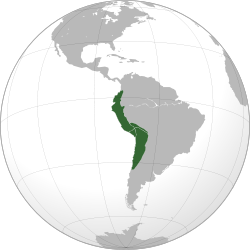Realm of the Four Parts Tawantinsuyu (Quechua) | |||||||||||||||||||
|---|---|---|---|---|---|---|---|---|---|---|---|---|---|---|---|---|---|---|---|
| 1438–1533/1572 | |||||||||||||||||||
 The Inca Empire at its greatest extent, c. 1525 | |||||||||||||||||||
| Capital | Cuzco | ||||||||||||||||||
| Official languages | Classical Quechua; Aymara language before reign of Huayna Capac[1] | ||||||||||||||||||
| Common languages | Quechuan languages, Aymaran languages, Puquina language, Mochica language, Barbacoan and scores of other smaller languages. | ||||||||||||||||||
| Religion | Inca religion | ||||||||||||||||||
| Government | Divine, absolute monarchy semi-diarchy | ||||||||||||||||||
| Sapa Inca | |||||||||||||||||||
• 1438–1471 | Pachacuti | ||||||||||||||||||
• 1471–1493 | Topa Inca Yupanqui | ||||||||||||||||||
• 1493–1525 | Huayna Capac | ||||||||||||||||||
• 1525–1532 | Huascar | ||||||||||||||||||
• 1532–1533 | Atahualpa | ||||||||||||||||||
| Historical era | Pre-Columbian era | ||||||||||||||||||
• Pachacuti created the Tawantinsuyu | 1438 | ||||||||||||||||||
| 1529–1532 | |||||||||||||||||||
• Spanish conquest led by Francisco Pizarro | 1533/1572 | ||||||||||||||||||
• End of the last Inca resistance | 1572 | ||||||||||||||||||
| Area | |||||||||||||||||||
| 1527[2][3] | 2,000,000 km2 (770,000 sq mi) | ||||||||||||||||||
| Population | |||||||||||||||||||
• Early 16th century[4] | 12 million | ||||||||||||||||||
| |||||||||||||||||||
| Inca Empire |
|---|
 |
| Inca society |
| Inca history |
The Inca Empire,[a] officially known as the Realm of the Four Parts (Quechua: Tawantinsuyu, lit. "land of four parts"[5]), was the largest empire in pre-Columbian America.[6] The administrative, political, and military center of the empire was in the city of Cusco. The Inca civilization rose from the Peruvian highlands sometime in the early 13th century. The Spanish began the conquest of the Inca Empire in 1532 and by 1572, the last Inca state was fully conquered.
From 1438 to 1533, the Incas incorporated a large portion of western South America, centered on the Andean Mountains, using conquest and peaceful assimilation, among other methods. At its largest, the empire joined modern-day Peru, what are now western Ecuador, western and south central Bolivia, northwest Argentina, the southwesternmost tip of Colombia and a large portion of modern-day Chile into a state comparable to the historical empires of Eurasia. Its official language was Quechua.[7]
The Inca Empire was unique in that it lacked many of the features associated with civilization in the Old World. Anthropologist Gordon McEwan wrote that the Incas were able to construct "one of the greatest imperial states in human history" without the use of the wheel, draft animals, knowledge of iron or steel, or even a system of writing.[8] Notable features of the Inca Empire included its monumental architecture, especially stonework, extensive road network (Qhapaq Ñan) reaching all corners of the empire, finely-woven textiles, use of knotted strings (quipu or khipu) for record keeping and communication, agricultural innovations and production in a difficult environment, and the organization and management fostered or imposed on its people and their labor.
The Inca Empire functioned largely without money and without markets. Instead, exchange of goods and services was based on reciprocity between individuals and among individuals, groups, and Inca rulers. "Taxes" consisted of a labour obligation of a person to the Empire. The Inca rulers (who theoretically owned all the means of production) reciprocated by granting access to land and goods and providing food and drink in celebratory feasts for their subjects.[9]
Many local forms of worship persisted in the empire, most of them concerning local sacred huacas or wak’a, but the Inca leadership encouraged the sun worship of Inti—their sun god—and imposed its sovereignty above other religious groups, such as that of Pachamama.[10] The Incas considered their king, the Sapa Inca, to be the "son of the Sun".[11]
The Inca economy, especially in the past, was often the subject of scholarly debate. Darrell E. La Lone, in his work The Inca as a Nonmarket Economy, noted that scholars have previously described it as "feudal, slave, [or] socialist," as well as "a system based on reciprocity and redistribution; a system with markets and commerce; or an Asiatic mode of production."[12]
- ^ Cerrón-Palomino, Rodolfo. Las lenguas de los incas: el puquina, el aimara y el quechua. Germany: PL Academic Research, 2013.
- ^ Turchin, Peter; Adams, Jonathan M.; Hall, Thomas D (December 2006). "East-West Orientation of Historical Empires". Journal of World-Systems Research. 12 (2): 222. ISSN 1076-156X. Retrieved 16 September 2016.
- ^ Rein Taagepera (September 1997). "Expansion and Contraction Patterns of Large Polities: Context for Russia". International Studies Quarterly. 41 (3): 497. doi:10.1111/0020-8833.00053. ISSN 0020-8833. JSTOR 2600793. Retrieved 7 September 2018.
- ^ ""La catastrophe démographique" (The Demographical Catastrophe"), L'Histoire n°322, July–August 2007, p. 17".
- ^ The Inka Empire. University of Texas Press. 2015. doi:10.7560/760790. ISBN 978-1-4773-0392-4.
- ^ Schwartz, Glenn M.; Nichols, John J. (2010). After Collapse: The Regeneration of Complex Societies. University of Arizona Press. ISBN 978-0-8165-2936-0.
- ^ "Quechua, the Language of the Incas". 11 November 2013. Archived from the original on 27 June 2019. Retrieved 5 January 2019.
- ^ McEwan, Gordon F. (2006). The Incas: New Perspectives. New York: W.W. Norton & Co. p. 5.
- ^ Morris, Craig and von Hagen, Adrianna (2011), The Incas, London: Thames & Hudson, pp. 48–58
- ^ "The Inca - All Empires". www.allempires.com. Archived from the original on 29 February 2024. Retrieved 27 December 2023.
- ^ "The Inca". The National Foreign Language Center at the University of Maryland. 29 May 2007. Retrieved 10 September 2013.
- ^ La Lone, Darrell E. (1982). "The Inca as a Nonmarket Economy: Supply on Command versus Supply and Demand". Contexts for Prehistoric Exchange: 292. Retrieved 10 August 2017.
Cite error: There are <ref group=lower-alpha> tags or {{efn}} templates on this page, but the references will not show without a {{reflist|group=lower-alpha}} template or {{notelist}} template (see the help page).